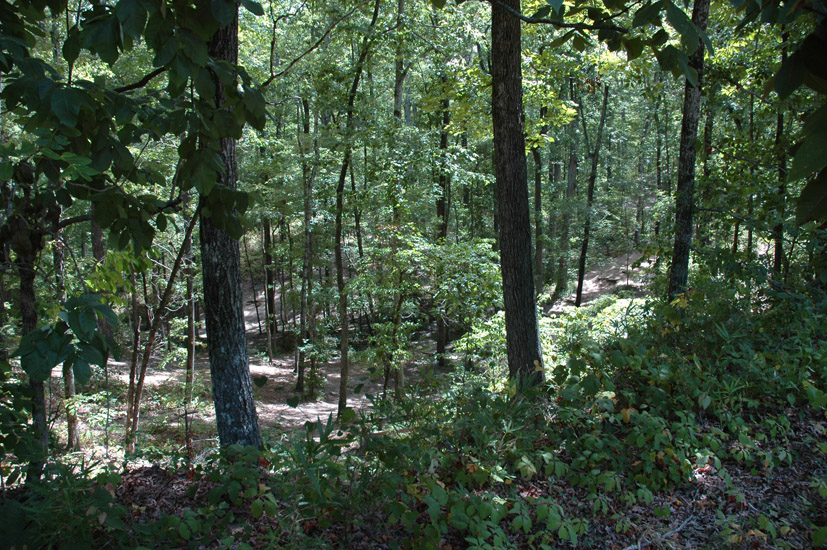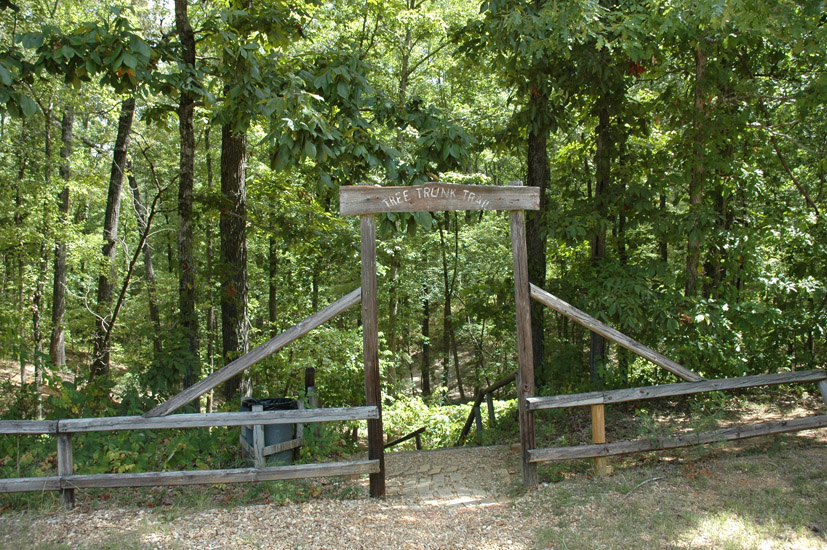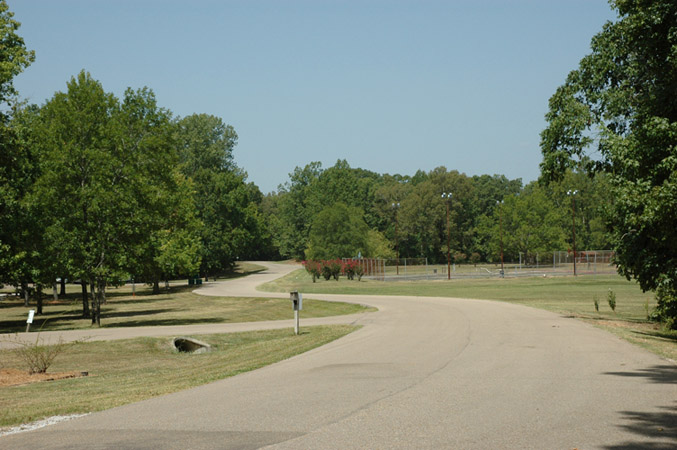Ants in Tombigbee State Park, Lee County, Mississippi [MS State Park Ants]
Joe A. MacGown and JoVonn G. Hill
Tombigbee State Park is located about six miles south of Tupelo, in Lee County, Mississippi. The park covers some 702 acres and includes a 102 acre spring-fed lake. Cabins and campsites and a variety of activities are available including a beautiful nature trail, which curves its way through a very hilly hardwood forest.
A view of the forest at Tombigbee State Park
We arrived at Tombigbee State Park on 3 August 2006 at approximately 9:15 A.M. on another sweltering hot day. At least most of our collecting would be in the woods, where some respite from the heat could be found. We stopped at the gatehouse to let somebody know our plans for ant collecting in the park. Noel, the fellow working the gatehouse, was more than welcoming and seemed excited that we were there to collect. He was especially happy to see that we were from Mississippi State University, where he had gone to school many years before. While we talked with him, he mentioned his remedy for keeping ticks off of his dogs. He said that feeding them garlic tablets really helped. He gave us a couple of maps of the park, and we headed in.
We made a quick circuit of the park and decided to begin collections on the "Tree Trunk Nature Trail" (34°13'48"N 88°37'06"W), which would its way through a hardwood forest with lots of oaks and hickories on steep slopes. The soil was extremely dry, almost dusty, due to the lack of any appreciable recent rainfall over the last two or three months. A disc golf course, an increasingly popular activity, also passed through this area and intersected the beginning of the nature trail. As we got out of the truck we immediately spotted Pheidole dentata Mayr running around on the ground. Following some minor workers resulted in the discovery of a colony in the soil under a brick that was placed next to a wooden fence bordering the parking area. This was a fairly large colony and alate queens were present. This species was quite common at this site and colonies were found scattered throughout the area. In one of these colonies alate males were found and collected. Pheidole bicarinata Mayr colonies were seen in the soil along the roadside and the trail through the forest. Two dolichoderine species, Dorymyrmex bureni (Trager) and Forelius mccooki (McCook) were also found nesting on the roadside near the nature trail. Both of these species are fast moving, common ants that are often found in open areas, such as along roadsides. Surprisingly, no fire ants were found along the roadside in this area.
The entrance to Tree Trunk Trail
Workers of the black carpenter ant, Camponotus pennsylvanicus (DeGeer), were seen in great numbers foraging on the ground and on trees throughout the forest. The so-called red carpenter ant, Camponotus chromaiodes Bolton, was found nesting in a rotting stump. Although this species is called the red carpenter ant, it is often more blackish in appearance and can be easily confused with the black carpenter ant. Another species of carpenter ant, Camponotus americanus Mayr, was found nesting in the soil under a large exposed tree root than ran laterally across the trail. This species has a orangish-brown body and a black head.
Workers of the orangish-red Formica pallidefulva Latreille, which is related and similar looking to the carpenter ants, were also very common in this hardwood forest. Several colonies were evident in the soil, with many of them under roots or wooden steps that had been placed in the trail to aid hikers in climbing some of the hills. A black species, Formica subsericea Say, was also found and appeared to be more common along the higher parts of the trail. Lasius americanus Emery, another related, but smaller ant, was found to be common along lower areas in leaf litter.
While searching for ants under a large log, which was not yet rotting, and individual of the Eastern ant cricket, Myrmecophilus pergandei Bruner, was found. The cricket very quickly scampered away and jumped into a small hole located on the underside of the log. However, by using an aspirator, the cricket was sucked up from its hiding place and collected. These crickets are myrmecophiles that are associated with a variety of ant species (MacGown and Hill, 2006). In this instance, the cricket was not observed to interact with any ants, but a couple of species, Aphaenogaster carolinensis and Solenopsis carolinensis, were found underneath the log in the same area of where the cricket was found.
Searching through leaf litter revealed the presence of several common species including Hypoponera opacior (Forel), Strumigenys louisianae Roger, Solenopsis carolinensis, Aphaenogaster lamellidens, and Aphaenogaster carolinensis. We also collected 5 gallons of leaf litter, which we took back to the lab for Berlese funnel extraction. Several additional species were collected in these samples including Brachymyrmex depilis Emery, Strumigenys angulata Smith , Strumigenys ornata Mayr, Aphaenogaster treatae Forel, Pheidole dentigula Smith, Crematogaster ashmeadi Mayr, and Temnothorax curvispinosus Mayr. Several more specimens of the ant loving cricket were also found in the litter samples.
Before leaving this area, we checked our peanut butter bait, which had been splashed on some oaks trees at near the entrance of the trail. The bait at most of the trees was completely covered with the little black ant, Monomorium minimum (Buckley). These little ants formed such a solid mass that they appeared to be one large black splotch on the tree. Moving in for a closer look caused the ants to leave the bait en masse. The black carpenter ant, which was also collected at the bait, had a different strategy than the little black ants. They approached the bait individually only staying briefly, ever wary of some predator (like an ant collector). Aphaenogaster lamellidens Mayr was found at the bait on one of the trees. They are interesting to watch as they carefully cut up the peanut butter with their mandibles, which they then roll into a ball and place between their fore coxae and the underside of their heads. While still grasping the ball of peanut butter, the workers then carried the booty to their colony. The size of the bait appeared to be very uniform between different workers, apparently being the ideal size and weight to carry efficaciously. One other species of ant, Temnothorax schaumii Roger, was collected at peanut butter. These ants are also very different in their habits than the other species found at the bait. They are dark colored and very slow moving. To find this ant on the tree it is necessary to look at the bark carefully because the ants are so cryptic they are almost impossible to see. Trying to catch one can be difficult as well, because if you miss, they scoot under the nearest crevice where they remain motionless for a while.
We left the nature trail area and went over to a nearby pavilion, that was very near the office and the lake, and we ate some lunch, such as it was. We then collected in the surrounding woods. The ants we found here were basically the same species that we had found earlier, which was to be expected. Nonetheless, we collected two more bags of litter. However, these two litter samples did not add any species to the ones we had already collected.
One of the reasons we wanted to stop at the pavilion area, was that we had spotted some ash trees in the nearby parking lot that we wanted to check out for arboreal species of ants. Colobopsis mississippiensis (Smith) is a rarely collected species that is only known to nest in ash stems, and it was this species that we were specifically searching for. As we looked at some low hanging limbs, we saw what appeared to be entrance holes of the ant, but no ants were found. As we continued looking and splitting open a few branches with holes, we found another species of ant, Crematogaster ashmeadi, common species of acrobat ant. It is likely that this species did not actually make the galleries in the branches, but instead was utilizing an old colony of the Camponotus. When we were almost to the point of giving up, when we finally found a colony of the ants we were looking for and collected some representatives of both minor and major workers.
The road through the park
As we were roaming the parking area looking at ash trees, we also perused the ground to see if we could find the presence of any of the imported fire ants. Although we saw several small mounds that were likely the nests of these marauding beasts, we had no luck in actually finding any workers. The lack of these ants was probably due to control measures taken by park personnel, because no other logical explanation would have accounted for their absence in this part of the state. However, we didn't have time to search the entire park, and it is likely that they were present somewhere within the confines of the park.
Two additional species, Camponotus decipiens Emery and Crematogaster minutissima Mayr, are known to occur in the park from other collections, and those specimens are stored in the Mississippi Entomological Museum. Camponotus decipiens is a bicolored red and black carpenter ant that typically nests in cavities of various plants. Crematogaster minutissima is a minute, pale yellow species that nests in rotting wood or in the soil, usually in forested habitats.
On 5 May 2010, a return trip to the park was made by MacGown, Hill, and James Lewis. We collected at the RV campground at 34°13'45"N 88°37'10"W and near the park entrance at a pull-off near the lake (34°13'49"N 88°37'36"W). Collections were made in the mid afternoon with temperatures in the mid 80's F. The campground was located in an open hardwood forest with open mowed areas beneath the trees. Fire ants (Solenopsis invicta x ricteri) were abundant, as were Forelius mccooki, Pheidole bicarinata, P. dentata, and P. tysoni. The second site we collected in near the park entrance was a sloped hardwood forest by a lake. We observed numerous Trachymyrmex septentrionalis colonies. We watched one colony as some workers carried bits of dirt out one entrance to the colony and others carried bits of leaves, insect feces, and other material that looked like moss into another entrance hole. We collected nine additional species for the park including Camponotus castaneus, C. snellingi, Crematogaster missuriensis, Nylanderia arenivaga, N. vividula, Pheidole soritis, P. tysoni, Temnothorax pergandei, and Trachymyrmex septentrionalis.
Based on these collections and others, we have records of 44 species of ants in the park. Most of the ants collected at Tombigbee State Park are relatively common species, and no ants representing new state records for Mississippi were found. Among the more interesting ants we collected were Camponotus mississippiensis, Stigmatomma pallipes, Strumigenys angulata, and Temnothorax schaumii. This species of Camponotus is noteworthy because of its habit of making colonies in small branches of white ash trees (and possibly other ashes). The major workers of this species have specially modified heads which are truncated in the front. They use this flattened area at the front of their head as a doorway at the colony entrance. Stigmatomma pallipes is a very unique subterranean ant with large bidentate mandibles, and before recent collections by the Mississippi Entomological Museum, this species was only known from the state by a couple of specimens. In recent years we have found this species to be fairly common throughout the state, although we never find them in large numbers. Strumigenys angulata is considered to be a rare species in the United States, but is relatively common in many rich forested areas in Mississippi. Temnothorax schaumii is another species that was once thought to be quite rare, but one that we now find with regularity on oak trees (and occasionally other trees).
List of ant species (arranged alphabetically)
Aphaenogaster carolinensis (Wheeler)
Aphaenogaster fulva Roger
Aphaenogaster lamellidens Mayr
Aphaenogaster treatae Forel
Brachymyrmex depilis Emery
Camponotus americanus Mayr
Camponotus castaneus (Latreille)
Camponotus chromaiodes Bolton
Camponotus decipiens Emery
Camponotus pennsylvanicus (DeGeer)
Camponotus snellingi Bolton
Colobopsis mississippiensis (Smith)
Crematogaster ashmeadi Mayr
Crematogaster lineolata (Say)
Crematogaster minutissima Mayr
Crematogaster missuriensis Emery
Dorymyrmex bureni (Trager)
Forelius mccooki (McCook)
Formica pallidefulva Latreille
Formica subsericea Say
Hypoponera opacior (Forel)
Lasius americanus Emery
Monomorium minimum (Buckley)
Myrmecina americana Emery
Nylanderia arenivaga (Wheeler)
Nylanderia faisonensis (Forel)
Nylanderia vividula (Nylander)
Pheidole bicarinata Mayr
Pheidole dentata Mayr
Pheidole dentigula Smith
Pheidole soritis Wheeler
Pheidole tysoni Forel
Ponera pennsylvanica Buckley
Solenopsis carolinensis Forel
Solenopsis invicta X richteri
Stigmatomma pallipes (Haldeman)
Strumigenys angulata Smith
Strumigenys creightoni Smith
Strumigenys ornata Mayr
Strumigenys louisianae Roger
Temnothorax curvispinosus Mayr
Temnothorax pergandei (Emery)
Temnothorax schaumii Roger
Trachymyrmex septentrionalis (McCook)
MacGown, J. A. and J. G. Hill. 2006. The Eastern ant cricket, Myrmecophilus pergandei Bruner (Orthoptera: Myrmecophilidae), reported from Mississippi, U.S.A. Journal of the Mississippi Academy of Sciences 51: 180-182. [pdf]





